May 15 - 21 2016: Issue 263
Marvellous Marbles: An All Ages Preoccupation for Collectors
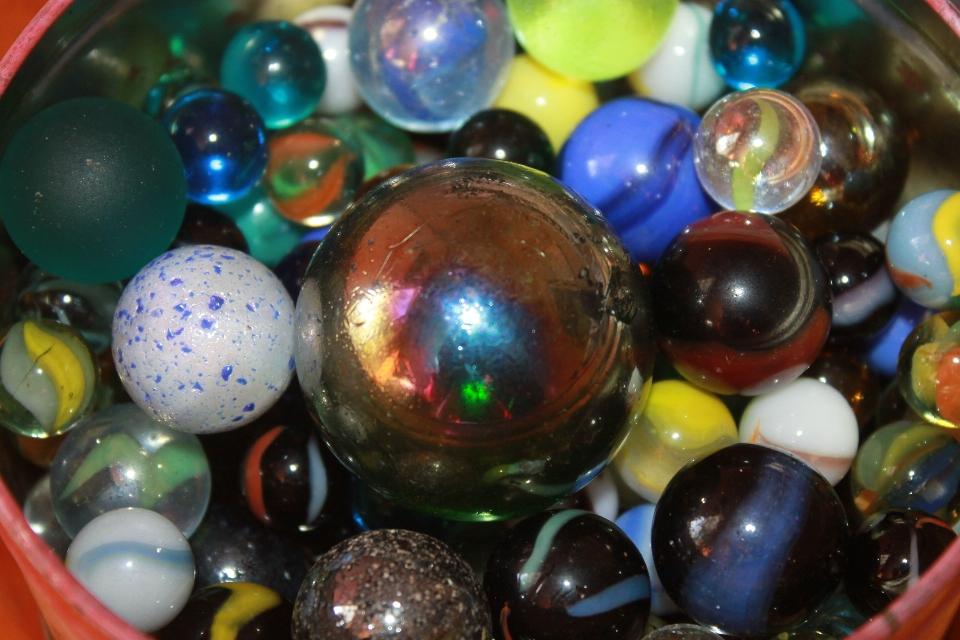
‘What are you going to make of your boy?' asked the visitor of the fond mother;
‘I think he will be a great sculptor,' was the reply. -
' Has he any talent that way ?'
' I should think so. Why, they tell me that he is perfect in chiselling boys out of marbles.'
A POEM. (1895, May 4). The Daily News (Perth, WA : 1882 - 1950), , p. 3. Retrieved from http://nla.gov.au/nla.news-article78357224
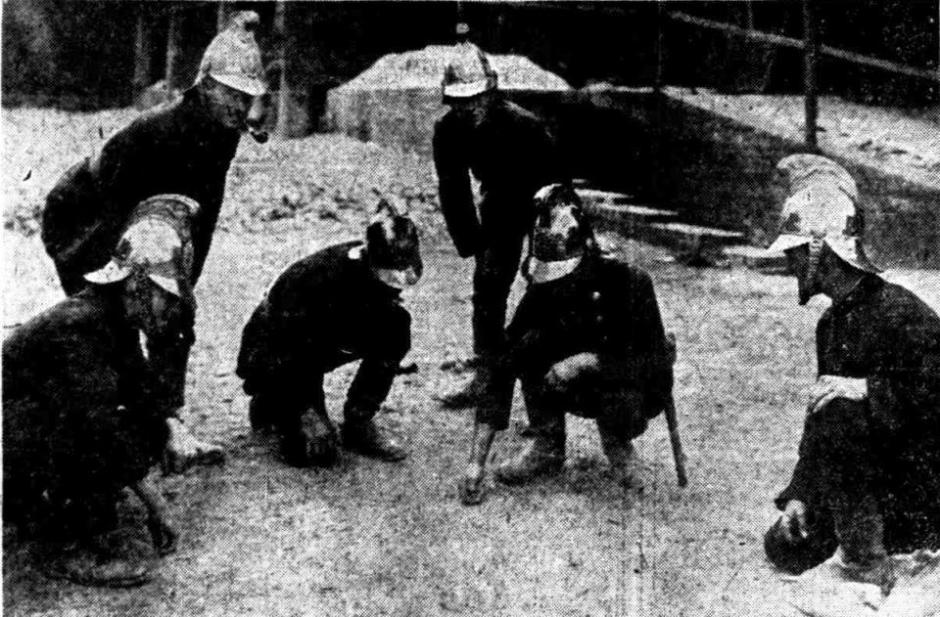
WOODVILLE FIREMEN LEAVE THEIR HOSES TO PLAY MARBLES
Members of Woodville Brigade attended the premises of the Australian Glass Manufacturers' Company Limited, recently when the cauldrons of molten glass were emptied. During a respite from work several of the firemen retrieved a number of alleys from broken bottles enjoyed a game of marbles. WOODVILLE FIREMEN LEAVE THEIR HOSES TO PLAY MARBLES (1929, April 3). News (Adelaide, SA : 1923 - 1954), , p. 5 (HOME EDITION). Retrieved from http://nla.gov.au/nla.news-article129114149
Marvellous Marbles: An All Ages Preoccupation
Tigers eyes and Cat’s eyes, Aggies and Shooters or taws and games which included ‘bombers’ and keeping any knocked out of the ring, everyone has played with or had brothers who have played with and collected marbles. The beautiful colours, the fights over who owns which marble overseen by a mum who has a great memory for whose is whose during meditation, all these fill memories of many of us.
A recent rummage through the cupboards here disclosed a round tin filled with marbles from the childhood of a soon to be 60 year old. When a suggestion was made that they be given to someone of smaller limbs and younger years the look of horror, the cry of protest, emphasises that collecting and playing with marbles is not restricted to those still in their childhood.
Found in mudflats along our shorelines, rolling around in desks decades after the forms of schoolyards are swapped for those in high rise offices, the humble marble is something most of us have one or two keepsakes of, they are the one toy that prove many of us still have a spark of child in us, no matter how long we live!
In Sydney they were among the 'necessities' brought out by ships and so important to youngsters here they rated a mention in this advertisement:
ON SALE at Luke Dillon's, No. 9, George-street, a valuable INVESTMENT, imported on the Ship Admiral Cockburn',Captain Briggs; comprising saddlery by the first London makers, top, Heshian, and Wellington boots, ladies' walking and coloured kid shoes, fashionable writing desks, tea caddies, back-gammon boards, hair, tooth, nail, and clothes brushes, chip's compass, muskets, trowels, ready-made clothes, bed sackings, tapes and bobbings, white stocking web, toys, marbles, bibles,.testaments, and spelling books, lampblack, hand saws,. wine glasses, liquor bottles, good Braz'd tobacco by the basket, and teas and sugar- Classified Advertising (1819, September 4). The Sydney Gazette and New South Wales Advertiser (NSW : 1803 - 1842), , p. 3. Retrieved from http://nla.gov.au/nla.news-article2178936
The game itself is thousands of years old, some estimate over 4000 years old, with excavations near Mohenjo-daro uncovering balls of stone dated to over four and half thousand years ago. Marbles were also mentioned in Roman literature, like Ovid's poem Nux about nuts playing and there are numerous examples of marbles from Chaldeans of Mesopotamia and ancient Egypt.
In Australia, games were played with marbles of different sizes. The smallest and most common was about 15 mm in diameter. The two larger, more valuable sizes were referred to as semi-bowlers and tom-bowlers, being about 20 mm and 25 mm in diameter respectively. They were used in much the same way as ordinary marbles, although sometimes they would be declared invalid because of the advantage of their larger mass and inertia. Owners of large marbles were also afraid to use them lest they be lost to another player as "keepsies". They were usually of the clear "cat's eye" or milk glass type, just bigger.
A very popular game with variety in its play was "Bunny Hole". The winner of this game was he who was first able to hit the other player's marble four times, but this had to be achieved under certain constraints. A hole (called the "bunny hole") was dug by pivoting the heel of the foot into the sand or dirt. A line was then marked out some 20 feet [6 metres] away, and each player in turn then pitched his/her marble from the line to see who could rest the marble nearest the bunny hole. The person whose marble came to rest nearest the hole would go first. This player would then attempt to 'fire' his marble in a manner so as to rest it in the hole. No 'hits' on other marbles were accounted to any player until (s)he had successfully played his/her own marble into the bunny hole.
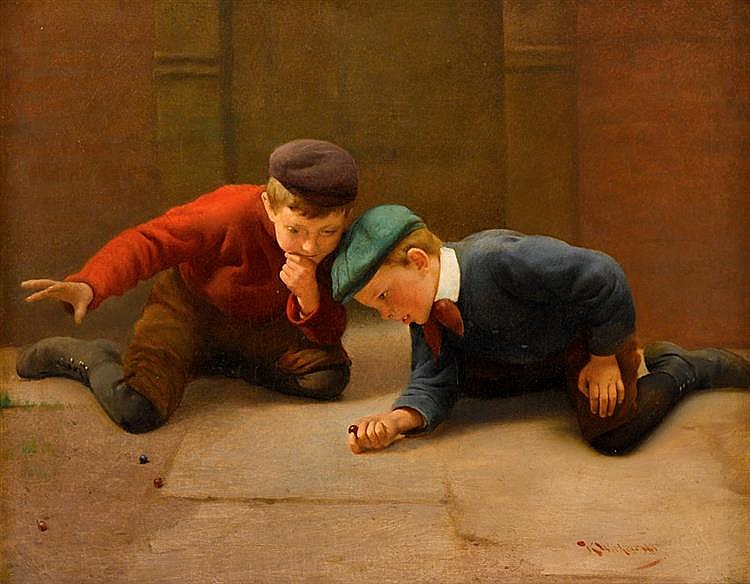
'Boys Playing Marbles' by Karl Witkowski (1860-1910)
"Firing" a marble meant that a player had to flick his/her marble from a stationary position of his hand. No part of the hand firing the marble was permitted to be in front of the position where the marble had been resting on the ground. Using that hand, (s)he would flick or fire the marble from his/her hand, usually with the knuckle on the back of his/her hand resting on the ground, and usually using the thumb of that hand to do so. All shots of the game were conducted in this manner throughout except the very initial pitch towards the bunny hole that commenced the game.
Once a player was able to land his/her marble within the hole, (s)he would immediately then fire his marble at his opponents' marbles. However, if any player hit another player's marble before his/her own marble had been to 'visit' the bunny hole, the act would be referred to as "a kiss"; the game would be over, and all or both players (in the case of two players only) would have to retreat back to the starting line to re-commence the game, without result. This, of course, could be quite annoying or frustrating if a player had already built up quite a few hits on another player's marble! So, most skilled players did not resort to this kind of tactic. [1]
Collecting marbles for value sake has become big business worldwide though, with some reports stating over 40 thousand dollars has been paid for a single rare item and some collectors selling others for 11 thousand each. The value of each is defined by the same thing for all collectibles: “Rarity, desirability, and condition.”
Dealers and collectors are after that rare marble that might have beautiful swirls of colours in them, and knowing which is which requires an education in itself.
Marbles were first manufactured in Germany in the 1800s. Ceramic marbles entered inexpensive mass production in the 1870s. A German glassblower invented marble scissors in 1846, a device for making marbles. The first mass-produced toy marbles (clay) made in the U.S. were made in Akron, Ohio, by Sam C. Dyke, in the early 1890s. Some of the first U.S.-produced glass marbles were also made in Akron, by James Harvey Leighton. In 1903, Martin Frederick Christensen—also of Akron, Ohio—made the first machine-made glass marbles on his patented machine. His company, The M. F. Christensen & Son Co., manufactured millions of toy and industrial glass marbles until they ceased operations in 1917. The next U.S. company to enter the glass marble market was Akro Agate. This company was started by Akronites in 1911, but was located in Clarksburg, West Virginia. Today, there are only two American-based toy marble manufacturers: Jabo Vitro in Reno, Ohio, and Marble King, in Paden City, West Virginia.
So if you're collecting them for an investment, what do you need to know? - a bit about what kinds there are and their era of production:
Eras
Material Country of Origin Era of Production
Glass - Handmade Germany About 1850 to 1900
Glass - Machine Made United States About 1910 to 1940
Glass - Machine Made Japan About 1950
Glass - Machine Made Mexico or China Very Recent
Clay, Agate, or Other Stone - Handmade Germany About 1850 to 1900
Experts state you should join a marbles group or deal only with a reputable seller when trading in these.
OLD HAND MADE GERMAN SWIRL GLASS MARBLE COLORFUL CANDY RIBBON BANDED CORE NAKED. ORIGINAL SURFACE PONTILS HARD TO FIND EARLY GERMANY VGC. Currently for sale on ebay USD $36.00 - $48.60 AUD
What to look for
Antique marbles were mostly created through glassblowing, and there are characteristics to look for; the pontil being the most obvious. When made by hand, a marble was attached to a stick as part of the process of glassblowing. When done the stick was broken off at the end leaving a small rough patch where the stick was attached to the marble; this roughness is the 'pontil'. These 'handblown' versions are also likely to have bubbles or flaws.
Another thing to look for is the quality of the glass- older marbles were all made from a very high quality of this substance:
Stone versions are rare too - possibly because some of the materials were quite dangerous to deal with due to their being a little bit more work to make:
MARBLES.
Most of the stone marbles used by boys are made in Germany. The refuse only of the marble and agate quarries is employed and this is treated in such a way that there is practically no waste. Men and boys are employed to break the refuse stone into small cubes; and with their hammers they acquire a marvellous dexterity. The small cubes are then thrown into a mill consisting of a grooved ledstone and a revolving runner. Water is fed to the mill, and the runner is rapidly revolved, while the friction does the rest. In half an hour the mill is stopped and a bushel or so of perfectly-rounded marbles taken out. The whole process costs the merest trifle. MARBLES. (1922, May 27). The Journal (Adelaide, SA : 1912 - 1923), , p. 6 (NIGHT EDITION). Retrieved from http://nla.gov.au/nla.news-article200916903
• Aggie - made of agate (aggie is short for agate) or glass resembling agate, with various patterns like in the alley
• Alley or real - made of marble or alabaster (alley is short for alabaster), streaked with wavy or other patterns with exotic names like corkscrew, spiral, snake, ribbon, onyx, swirl, bumblebee, and butterfly
• Ade - strands of opaque white and color, making lemon-ade, lime-ade, orange-ade, etc.
• Cat's eye or catseye - central eye-shaped colored inserts or cores (injected inside the marble)
• Beachball - three colors and six vanes
• Devil's eye - red with yellow eye
• Red devil's - same color scheme as a devil's eye but swirly.
• Clambroth - equally spaced opaque lines on a milk-white opaque base. Rare clams can have blue or black base glass. Medium-high value for antique marbles; rare base color valued much higher.
• Lutz - antique, handmade German swirl, containing bands of fine copper flakes that glitter like gold. Erroneously thought to have been invented by noted glassmaker Nicholas Lutz. Medium-high value for antique marbles, depending on specific sub-type of Lutz design.
• Oilie or oily - opaque with a rainbow, iridescent finish
• Onionskin - antique, handmade German swirl, with many closely packed surface streaks. Medium price range for antique marbles.
ONIONSKIN 1880'S WITH SUSPENDED MICA MARBLE. Currently listed in ebay for $232.00 USD - $316.2 AUD
• Opaque - a popular marble that comes in many colors
• Oxblood - a streaky patch resembling blood
• Pearls - opaque with single color with mother of pearl finish
• Toothpaste - also known as plainsies in Canada. Wavy streaks usually with red, blue, black, white, orange.
• Turtle - wavy streaks containing green and yellow
• Bumblebee - modern, machine-made marble; mostly yellow with two black strips on each side
• China - glazed porcelain, with various patterns similar to an alley marble. Geometric patterns have low value; flowers or other identifiable objects can command high prices.
• Plaster - a form of china that is unglazed
• Commie or common - made of clay; natural color or monochrome coloration. Made in huge quantities during 19th and early 20th centuries.
• Bennington - clay fired in a kiln with salt glaze—usually brown, often blue. Other colorations fairly scarce. Fairly low value.
• Crock - made from crockery (earthenware) clay
• Croton alley or jasper - glazed and unglazed china marbled with blue
• Crystal or clearie or purie - any clear colored glass - including "opals," "glimmers," "bloods," "rubies," etc. These can have any number of descriptive names such as "deep blue sea", "blue moon", "green ghost", "brass bottle".
• Princess - a tinted crystal
• Galaxy - modern, machine-made marble; lots of dots inserted to look like a sky of stars
• Indian - antique, handmade German marble; dark and opaque, usually black, with overlaid groups of color bands; usually white, and one or more other colors. Can also have many colors like blue, green and scarlet. Medium price range for antique marbles.
• Mica - antique, handmade German marble; glassy to translucent with streaks or patches of mica, ranging from clear to misty. Value depends on glass color.
• Steely - made of steel; a true steely (not just a bearing ball) was made from a flat piece of steel folded into a sphere and shows a cross where the corners all come together.
• Sulphide - antique, handmade German marble; large (1.25 to 3+ inch) clear glass sphere with a small statuette or figure inside. Most common are domesticated animals such as dogs, cats, cows, etc.; then wild animals; human figures are scarce; inanimate objects such as a train or pocket watch are very rare and command high prices. The interior figures are made of white clay or kaolin, and appear a silvery color due to light refraction. A sulphide with a colored-glass sphere, or with a painted figure inside, is also very rare and brings a high price. Like other types of antique marbles, sulphides have been reproduced and faked in large quantities.
• Swirly - is a common marble made out of glass with one swirly color.
• Shooter- Any marble but in a bigger size.
• Tiger or Tiger's Eye - clear with orange-yellow stripes
• Baby - white with colours visible on the outside
A good online resource for all things marbles is The American Toy Marble Museum
The British and World Marbles Championship is an event that stems from 1588 during the reign of Elizabeth I, when marbles was chosen to be the deciding game of a legendary sporting encounter between two young suitors, Giles and Hodge, over the hand of a Tinsley Green milk maiden named Joan. Every popular sport of the day were contested, in an Olympic style contest lasting one week. Hodge had been victorious at singlestick, backsword, quarter staff, cudgel play, wrestling and cock throwing, while Giles was successful in winning the archery, cricket-a-wicket, tilting at quintain (jousting targets), Turk’s head, stoolball and tipcat. With the score level at 6 - 6, Good Friday was the date chosen for the final event, and marbles was chosen by the girl to be the deciding game, and Giles defeated Hodge.
Good Friday is the day the annually contested event takes place in its current format, since 1932, at the Greyhound public house in Tinsley Green, West Sussex. This is a team event, where teams of six players participate in a knock-out tournament to win the title and a silver trophy. The event is open to anyone of any age or nationality and over the years players from Australia, Belgium, Canada, Estonia, Ireland, France, Germany, Japan, Netherlands, Wales and USA have participated alongside the English teams. [2.]
In Australia a Marbles Championship was renewed in 2009 at Brunswick Heads and another has been running since 2010 in Parkes.
During the 1950's various places ran such tournaments, mostly for adult men!
Marbles
The following from the Sawmills have been selected to play Mourilyan Junior Farmers marbles at Callendar Park at 9am sharp on Sunday: — Jim Ewan, ''(Capt), Cecil Anderson (Vice Capt), Bill Elstob, Herb Robinson. Jack Romano, Dan Romano. MARBLES (1952, October 3). The Evening Advocate (Innisfail, Qld. : 1941 - 1954), p. 4. Retrieved from http://nla.gov.au/nla.news-article212581065
Clearly it is worth not 'losing your marbles' whether you keep them for nostalgic reasons or wish to hand on a small toy that is more valuable than the pennies once paid for them.
___________________________
References
1. Marble (toy). (2016, May 6). In Wikipedia, The Free Encyclopedia. Retrieved from https://en.wikipedia.org/w/index.php?title=Marble_(toy)&oldid=718892984
2. British and World Marbles Championship. (2016, April 17). In Wikipedia, The Free Encyclopedia. Retrieved fromhttps://en.wikipedia.org/w/index.php?title=British_and_World_Marbles_Championship&oldid=715659035
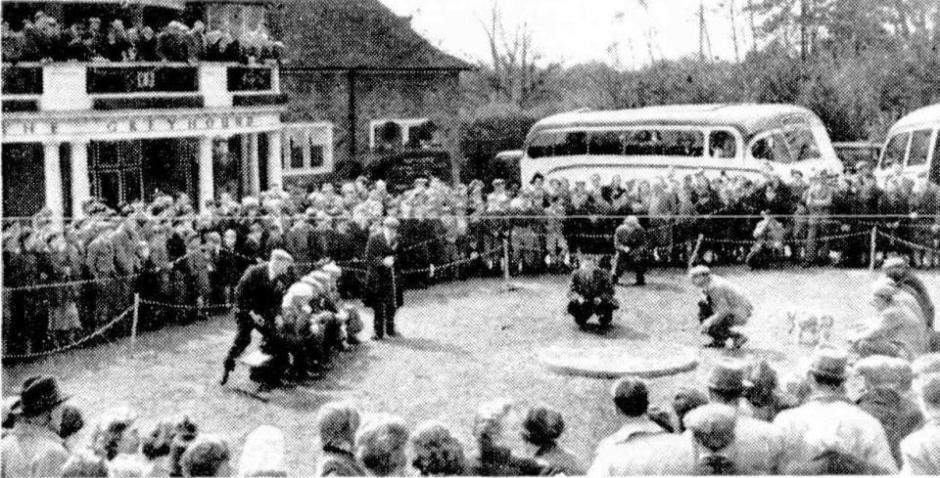
THE Greyhound Inn, at Tinsley Green, Surrey, England, is the scene of a traditional British Marbles Championship which has been fought out every Good Friday since Elizabethan days. It is reputed to have started with two young men competing for the hand of the village beauty. Shots From A Roving Camera (1952, April 24). Chronicle (Adelaide, SA : 1895 - 1954), , p. 40. Retrieved fromhttp://nla.gov.au/nla.news-article93868228
A few extras
MARBLES!
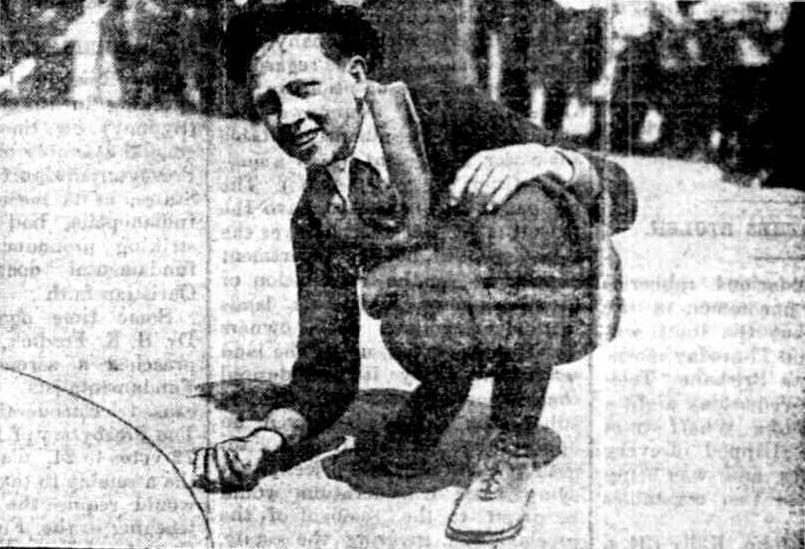
-Members of the U.S.A. Cabinet were amongst the spectators at a marbles tournament at Washington recently. Young Darne shown above, is to represent the capital at the National Marbles Tournament. MARBLES! (1923, July 25). Western Star and Roma Advertiser(Toowoomba, Qld. : 1875 - 1948), , p. 6. Retrieved from http://nla.gov.au/nla.news-article98192853
Marbles King
In a lovely corner of Sussex called Tinsley Green, an English, British, and, possibly, a world's marbles championship changed hands, with a London bus driver winning the title. Tinsley Green has been the scene, through three centuries, of historic matches in this final test of adult skill at one of the games in which youth has indulged since the dawn of time. Four teams contested the final on two rough clay patches which had been prepared. The individual championship carried with it the prize of an inscribed tankard. It had been held for years by Big Bert Botting — a Tinsley Green man — but this year he could score no more than four in the final, against a nine from F. S. Harding, the London bus-driver. Until the last year or so, Harding declares, he had not touched a marble since his boyhood. ITEMS OF INTEREST (1936, June 20).Voice (Hobart, Tas. : 1931 - 1953), , p. 5. Retrieved from http://nla.gov.au/nla.news-article219399361
UNCLE SAM IS NO 'FUDGER'
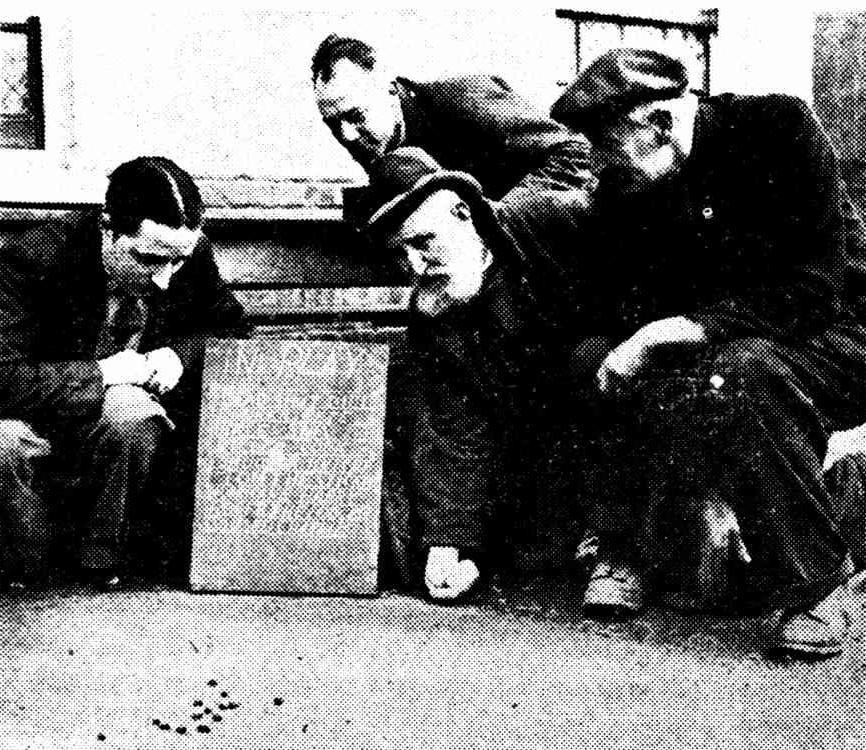
UNCLE SAM SPOONER, at 75 shows how he won the marbles championship of the world, 50 years ago. On the left is Tom the Sticker, on the right is Smugler Knight and above is Souse Charlie. The marbles championship has been played at Tinsley Green, Sussex, on the grounds of the Old Greyhound Inn, every Good Friday for the last 300 years. Among the opponents for the local team were sides from the air pilots, from the British railways, a team of Crawley busmen and a team from the Southern Railway. UNCLE SAM IS NO "FUDGER" (1937, April 9). The Daily News (Perth, WA : 1882 - 1950), , p. 16 (CITY FINAL). Retrieved from http://nla.gov.au/nla.news-article85701943
NB: ‘Fudging’ means you crossed the line on your shot, which is a minor form of cheating.
Veteran Shows How Marbles Should be Played
ON GOOD FRIDAY the marbles championship of thee world was decided at the Old Greyhound Inn, at Tinsley Green, Sussex, England. Here is "Uncle" Sam Spooner, 75, who won the championship 50 years ago, showing some of the Tinsley Green team how the game is played. Veteran Shows How Marbles Should be Played (1937, April 7). News (Adelaide, SA : 1923 - 1954), , p. 5. Retrieved fromhttp://nla.gov.au/nla.news-article131201000
Another report states he is 85 and has another version of his surname:
Sam Sponer, 85, who was marbles champion of England 50 years ago, shows his prowess to young admirers. He was present at the English championship — a 350 years' old event played recently at Tinsley Green, Sussex.

The MAIL BAG (1938, May 21). The Telegraph (Brisbane, Qld. : 1872 - 1947), p. 20 (SPORTS FINAL). Retrieved fromhttp://nla.gov.au/nla.news-article184124861
MARBLES & MAUNDY MONEY AT EASTER
Britain's Traditions
"The Age" Special Correspondent
LONDON. April 19.
None in the United Kingdom is more pleased to have beautiful sunny weather for the first day of the Easier holidays than contestants in the traditional British marbles championships held lo-day at Tinsley Green, in Sussex
According to local tradition marbles championships have been held there every Good Friday since the days of Queen Elizabeth, but they were suspended during the war. Today's match has attracted competitors from all parts of Britain, and it was filmed for .the newsreels. The oldest competitor was Sam Spooner, aged 80, who won the Tinsley Green championships In 1890. Flay Is supervised by art officially constituted British Marbles Control Board, which hopes to arrange International contests, and is in communication with the 'marbles executive board in New Zealand.
Ancient Pageantry
Another ancient tradition which marked the Easter holidays was the King's distribution of Maundy money in Westminster Abbey yesterday. Wearing the uniform of an admiral of the fleet, the King, attended by Yeomen of the Guard in scarlet and gold Tudor uniforms, and accompanied by officials of the Royal Almonry, carrying nosegays of flowers "against the plague."
Fifty-one men and 51 women were chosen ' to receive the Maundy money of 51 pence (one for each year of the King's age) in specially minted silver Maund pennies, tuppences, threepences and fourpences. After the ceremony -the King and Queen motored to Windsor Castle, where they entertained. A large Easter house party, including all members of the Royal family at present in England, and a number of young friends of the Princess Elizabeth, who celebrates her 20th birthday this week end. In honor of her birthday and by the King's command/the public will be admitted to the East terrace of the castle on Sunday afternoon, when the bands of the Royal Horse Guards and the Grenadier Guards will play,, and the Princess is expected to make an appearance. , Coastal holiday resorts have attracted huge crowds, and all railways and bus lines are crowded. Many London small businesses, including scores of restaurants, have closed down for a week or a fortnight to give employees a really worthwhile "Victors'" holiday. MARBLES & MAUNDY MONEY AT EASTER (1946, April 20). The Age (Melbourne, Vic. : 1854 - 1954), , p. 2. Retrieved from http://nla.gov.au/nla.news-article206100125
MARBLES.
Marbles, a game that was probably played by the cave men, is today played by some five millions in America, not to mention the millions in other countries, and it has now became a scientific game. The terrific interest in marbles is largely due to Barry Pink, one time Princeton Fellow, who learned some six or seven years ago that millions of old bottled cold cream jars and bits of glass were going to waste and straightway decided to go into the marble business. Now known as the Marble King, he turns out marbles at the rate of almost four million a day and long ago used up all the old glass supply. He awarded a University Scholarship annually to the winner of the annual marble- tournament. As a matter of fact, the oldest sporting event in England is the annual, marble tournament held in Tinsley Green since 1588. Every year some 4.000 spectators watch eight teams of seasoned marbellers, six men to a team, gravely kneel round a concrete bed to knock off opponent marbles. MARBLES. (1946, December 18). The Broadcaster(Fairfield, NSW : 1935 - 1978), p. 3. Retrieved from http://nla.gov.au/nla.news-article144145253
Marble King marbles are still sold today - visit their website for more information at: www.marblekingusa.com
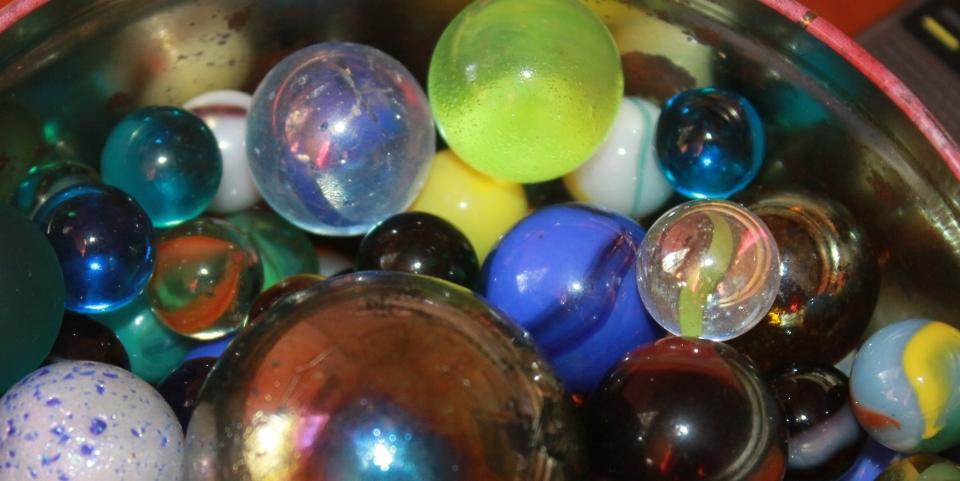
Marvellous Marbles: An All Ages Preoccupation for Collectors by A J Guesdon, 2016.
Previous Collectors Corner pages:
Blacksmiths and Tinsmiths Nylon Stockings Poster Art Furphy's Water Cart Mousehole Anvil Sapphire One Armed Bandit Gould's 1840 Single and Compound Microscope Tibetan Thangka Wheel Of Life Painting Cast Iron Seats Mabel Lucie Atwell Prints The Customs of Traditional Dining by Hans and Jenny Carlborg Albert Collins Landscape Boomerang Harmonicas Drinking: 18th Century Style Part I by H&J Carlborg Drinking 18th Century Style Part II by H&J Carlborg Fleece Shears Wood Case Crank Telephone 1803 Timepeice Vintage Guitars Milestones No.38 Rolls Royce Motor Oiler Christmas Postcards Seashells McCormick-Deering Horse Drawn Mower Rope Making Machine Marilyn Monroe 1955 Calendar Stubbie Holders Hill's Hoist Akubra Hat Fowler's Bottling Kit The Bold Autographed Script Fishing Tackle Arnotts Biscuit Tins Comic Books Silver Opium Pipe Mrs Beetons Book Souvenir Teaspoons Bendigo Pottery Gianelli Figurines Key Fobs Model Aircraft-static Porcelain Slippers Wagon Wheels Rhys Williams Painting Chinese Guardian Lions Australian Halfpenny Bud Vases Rolling Stones Still Life LP Autographed WL1895 Thinking Monkey Estee Lauder Ginger Jar Reel Mowers Surf Reels Millers Car Collection Hilton Lingerie - Slips Miniature Books of Verse - A Romantic Tradition REGA Pouring Can R O Dunlop - Sailing At Itchenor Painting Morning Shadows by C Dudley Wood The Father of Santa Claus - Xmas 2012 HMS Penguin Anchor at RPAYC - Newport SS Birubi Mast at RMYC - Broken Bay Helen B Stirling Ship's Wheel at Club Palm Beach Woomeras HMSEndeavour Replica Cannon at RPAYC The Doug Crane Classic Handmade Double Blade Paddle HMS BountyWooden Ship Model Collecting Ladies - Ferdinand Von Mueller and Women Botanical Artists Australian Bark Art Chinese Ginger Jars Hand Plough and Jump Stump Plough - Australian Inventions Frank Clune Books Frederick Metters - Stoves, Windmills, Iron Monger Trinket Boxes 1933 Wormald Simplex Fire Extinguisher is Pure Brass Chapman 'Pup' Maine Engines - Chapman and Sherack The Beach Ball Figureheads Salty Wooden Personifications of Vessels Binnacle at RMYC The Australian Florin - Worth More Than 20 Cents to Collectors Weathervanes; For Those Passionate About Seeing Which Way the Wind Blows Her Majesty's Theatre 1962 Programme - Luisillo and his Spanish Dance Theatre Cooper's Sheep Shower Enamel Sign and Simpson's and Sons of Adelaide Jolly Drover Sugar Bowl and English Pottery A Means to Gaze into the Past Chief Joseph and Edward S Curtis; His Remarkable Images of Native Americans an Inestimable Record of Images and Portrait Photographs His Masters Voice, Old 78's and Australia's Love of Music Jack Spurlings 'Tamar' Picture 1923 Resch's Beer Art - A Reflection of Australiana Now Worth Thousands The Compleat Angler - Izaak Walton's Discourse Inspires Generations of Fishers Portable Ice-Boxes and Coolers How Many Claim This Invention as Theirs? Malley's and Sons Ltd. - A Munificent Australian Family Company Vintage Paddles and Gigs Nautical Memorabilia The Crinoline - a 550 Year Old Fashion B.B. King - King of the Blues Goes Home: a Timely look into Photographs and Autographs and Being Buyer Aware Deep Down Among the Coral - By Christopher Corr - A Limited Edition Print in Celebration of the seventy fifth anniversary of QANTAS Airways Old Chinese Rice Bowls for Marriage: Worth More Than You Think... Commanderie St. John: An Ancient Wine - From 1927 with Lineage to Cyprus in 1210/92 and Methods of Production to Greece in 800 B.C. Pittwater Regatta Air Race Trophies: from 1934 and 1935 and The Pilot Who Saved William Hughes Vintage Brass Mortar and Pestle 1958 Bedford 'D' Truck and GM Holden Australian Made Car Bodies Heart Padlock Charm Bracelets for Newborns: A Golden Tradition